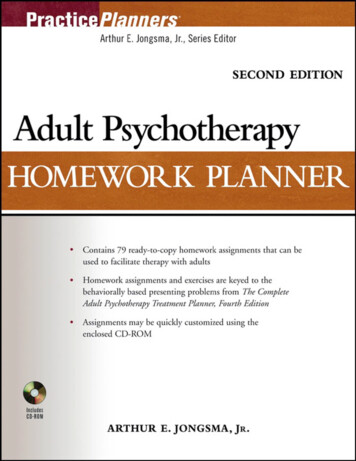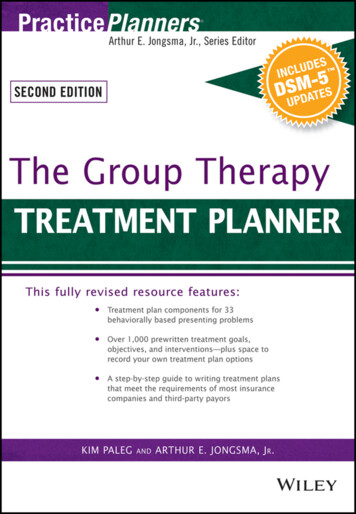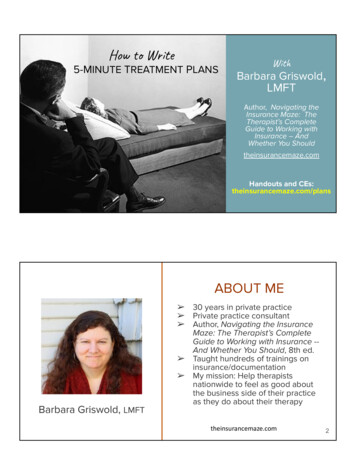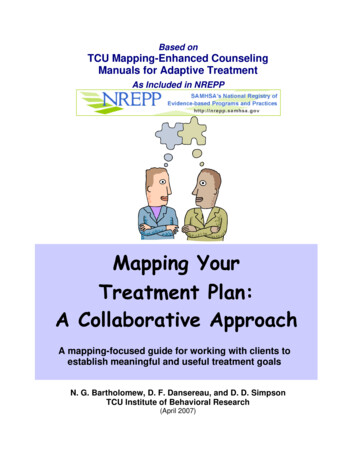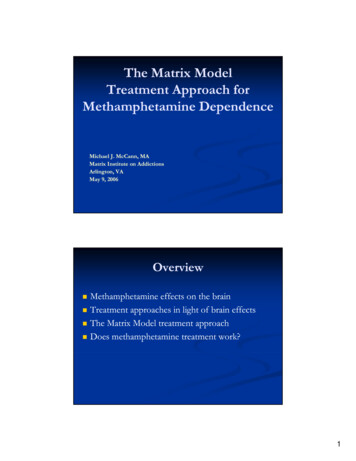
Transcription
The Matrix ModelTreatment Approach forMethamphetamine DependenceMichael J. McCann, MAMatrix Institute on AddictionsArlington, VAMay 9, 2006Overview Methamphetaminepeffects on the brainTreatment approaches in light of brain effectsThe Matrix Model treatment approachDoes methamphetamine treatment work?1
Meth Treatment is ChallengingA Major Reason PeopleTake a Drug is they LikeWhat It Does to Their BrainsNatural Rewards Elevate DopamineLevels200NAc 0120180Time (min)Source: Di Chiara et al.Copulation Frequenccy% of Basal DA OutpuutDA Concentration (% Basseline)FOOD200151050ScrScrScr ScrFemale 2 PresentBasFemale 1 PresentSample1 2 3 4 5 6 7 89 issionsEjaculationsSource: Fiorino and Phillips2
MORPHINE% of BBasal Release250 AccumbensDose (mg/kg)0.51.02.510200150100% of Basal Release001234Time After 23 hrTime After Nicotine400AccumbensCOCAINEDADOPACHVA3002001000% of Basaal Release% of Basal ReleaseEffects of Drugs on Dopamine e After CocaineAccumbens5 hrAMPHETAMINEDADOPACHVA01234Time After Amphetamine5 hrSource: Di Chiara and ImperatoMeth Treatment is ChallengingProlonged Drug Use Changesthe Brain In Fundamentaland LongLong--Lasting Ways3
Decreased dopamine transporter binding inMETH users resembles that inParkinson’’s Disease patientsParkinsonControlMethPDAvg. 3 yrs. abstinentSource: McCann U.D. et al.,Journal of Neuroscience, 18, pp. 8417-8422, October 15, 1998.4
“This is your Brain on Meth” Dr. Paul Thompson of UCLA; brain mappingstudy.Meth users in their 30s with 10 years of use.11% loss in brain pleasure/reward center tissue.He described “a forest fire” of brain damage.Navigating through daily life and applying whatis learned in treatment may be difficult(reminders, simplicity, redundancy)Meth in the Brain5
6
7
Methamphetamine:Neurochemical MechanismsEnters dopamine vesicles Vesicles deplete themselves of dopamine METHMETH8
METHMETHMeth Treatment is Challenging Prolongedg meth use changesg the brainProlonged effects require appropriate treatmentapproaches9
Effective Treatments forMethamphetamine DependenceThe Matrix Institute Establisheds b s d 19845 clinics in Southern CaliforniaSan Bernardino County 1985; 50% meth users10
Some Core Elements ofthe Matrix ModelElements of Effective Treatmentwith Methamphetamine Users Focus on the present; behavior vs feelingsStructure: 3 X week meetings; 16 weeksInformation on addiction and recoveryTeach relapse preventionUri ttestingUrinetiIntroduce and encourage selfself-help11
Matrix Program Schedule (Sample)MondayWeeks 1-4Early Recovery SkillsWeeks 1-16Relapse PreventionWednesdayWeeks 1-12Family/EducationWeeks 13-16Social SupportFridayWeeks 1-4Early Recovery SkillsWeeks 1-16Relapse PreventionUrine and breath alcohol tests once per week, weeks 1-16Ten Individual/Conjoint sessions during 1st 16 weeksSimple, redundant, & relevant information ClassicalCl i lconditioningdi i i andd cravingi The brain and addiction12
Information: ConditioningPavlov’s DogInformation: ConditioningPavlov’s Dog13
Conditioning Process DuringAddictionSocial PhaseStrength of Conditioned ConnectionTriggers Parties Special OccasionsMildResponses PleasantPleasant Thoughtsabout AOD No PhysiologicalResponse Infrequent UseDevelopment of Craving ResponseAddiction PhaseThinking ofUsingMild PhysiologicalResponse Heart Rate Breathing Rate Energy Adrenaline EffectsPowerful Physiological Use of AODsRResponse Heart Rate Breathing Rate Energy Adrenaline EffectsEntering UsingSiteAOD EffectsHeartBlood PressureEnergy14
Cognitive Process During AddictionDisenchantment PhaseSocial CurrencyOccasional EuphoriaRelief From LethargyRelief From StressNose BleedsInfectionsRelationship DisruptionFamily DistressImpending Job LossConditioning and the Brain:Message to Patients Will ppower,, goodgintentions are not enoughgBehavior needs to changeInsight will not affect cravingsD l withDealith cravings:iavoidid triggerstiDeal with cravings: thoughtthought-stoppingScheduling15
Treatment: Information & PersuasionDRUGEarly Recovery Skills Group Drugg cessationIdentify triggersGet rid of paraphernaliaAvoid triggerstriggers-schedule timeThought--stopping for cravingsThought12--step introduction1216
Matrix Model Key ComponentInformationThe Roadmap to RecoveryInformation: Roadmap for Recovery Withdrawal Early Abstinence, Honeymoon Protracted Abstinence, the Wall Adjustment/Resolution17
Information: the Wall Protracted Abstinence: “The Wall” 45--120 days after last use4518
Partial Recovery of Brain fromMethamphetamine After Abstinence30ml/gmMETH Abuser(1 month abstinent)Normal ControlMETH Abuser(14 months abstinent)Source: Volkow, ND et al., Journal of Neuroscience 21, 9414-9418, 2001.Dopamine improvements after 1 year, but not cognitive and motor functioningRoadmap for RecoveryReturn to OldBehaviorsAnhedoniaAngerDepressionEmotional SwingsUnclear ThinkingIsolationFamily ProblemsCravings ReturnAbstinence ViolationProtracted Abstinence19
The Wall Treatment implicationsSi lSimple Redundant Frequent visits for an extended period Message to patientsIt takest k a whilehil forf your brainb i tot healh l Don’t make mistakes explaining your feelings Be patient; Don’t give up Relapse Prevention Groups Relapsep Prevention Patients need to develop new behaviorsLearn to monitor signs of vulnerability torelapseRecovery is more than not using D.O.C.RRecoveryisi more thanth nott usingi drugsdanddalcohol20
Relapse Prevention Topics Relapse PreventionOOverviewi off theth concept;t thingsthidon’td ’t “just“j t happen”h” Using BehaviorOld behaviors need to changeRe--emergence signals relapse risk (it’s a duck)Re Relapse Justification“StinkingS k thinking”h k ”Recognize and stop Relapse Prevention Topics Dangerous Emotions Be Smart, not Strong L liLoneliness,anger, deprivationd i tiAvoid the dangerous people and placesDon’t rely on will powerAvoiding Relapse Drift Identifydentify “mooringmooring lineslines”Monitor drift21
Relapse Prevention Topics Total Abstinence Taking Care of Business Other drug/alcoholg/use impedesprecoveryy growthgDevelopment of new dependencies is possibleAddiction is fullfull--timeNormal responsibilities often neglectedTaking Care of Yourself Health, groomingNew selfself--imageRelapse Analysis Session to be done when relapse occurs after aperiod of sobriety Functional analysis Continued drug use is better addressed withEarly Recovery topics Relapse should be framed as learning experiencefor client22
Relapse and SexPeercent Respondinng"Yes"My sexual drive is increased by the use of 100908070605040302010085 385.370.655.655.343.9malefemale18.1 20.511 111.1opiatesalcoholcocainemethPrimary Drug of Abuse(Rawson et al., 2002)23
Perrcent Respondingg"Yes"My sexual pleasure is enhanced by the use of .416.0 18.211 111.1opiatesalcoholcocainemethPrimary Drug of Abuse(Rawson et al., 2002)Perccent Responding"Yes"My sexual performance is improved by the use of 100908070605040302010058.8 olcocainemethPrimary Drug of Abuse(Rawson et al., 2002)24
Other Components of theMatrix ModelFamily Education Lecture Conjoint Sessions Urine Testing SelfS lf HelpH lp InitiInitiationti n Matrix ModelUrinalysis And Breath Testing MethodM th d ffor MMonitoringit i TTreatmenttt ProgressP Treatment Accountability Assistance for Patient Reduces Arguments Provides Data for Family or Employer25
The “5%” Myth Myth: Only 5% of meth users are successful intreatmentDoes treatment work?Fact: Some treatments workEvidence--based treatmentsEvidenceMotivational Interviewingg Contingency Management Cognitive/Behavioral Treatment (Matrix Model) The “5%” Myth Wide dissemination may be selfself-fulfillingCommunities won’t support treatment Funders won’t fund treatment Meth users won’t enter treatment Practitioners won’t expect treatment to work 26
Comparison of Meth and Cocaine UsersRawson et al., 2000, Journal of Psychoactive Drugs 500 methamphetamine users224 cocaine usersMatrix San Bernardino CountyIdentical program and staffComparison of Meth and Cocaine UsersRawson et al., 2000, Journal of Psychoactive Drugs Identical treatment outcomesMean Weeks in Treatment100%24W eeeks2017.118MethCocaine881%87%80%1612% Clean Urines60%MethCocaine40%20%400%Weeks in Treatment% Clean Urines27
Matrix Model vs TAURawson et al., 2004, Addiction 978 Methamphetamine users seeking treatmentCSAT multimulti--site study; 19981998-2002Costa Mesa; San Diego; Hayward; Concord;San Mateo; Billings; Honolulu Matrix Model vs Treatment as UsualRandom assignmentBaseline DemographicsAge Male Education Meth use Marijuana use Alcohol use 32.8 years55%12.2 years7.5 years7 2 years7.27.6 years28
Route of Methamphetamine Use64%Percent Using by e of AdministrationWeeks in Treatment988.27Weeks65543**210MatrixTAU29
Weeks Continuous Abstinence766Weeks54332**10MatrixTAUMean Number of UA’s that wereMA--free during OeougoienDulolaesdarwMtaonHayHosCsrdcoginonCillB30
m ean num ber off visitsMean Number of Weeks in di egnMSaSaolnDonwaesdMorgss taaySaHHConcnlliCoBiSSITESelf-report of MA use during the past 30 daysat baseline, discharge, and 6-month follow-up.1211.3BaselineDischarge6-month FU10Days864.34.4420Matrix31
% meth-freeUrine Results: % MethMeth-free75%70%65%60%55%66%69%59%Discharge6 months12 months50%45%40%35%30%25%Matrix32
“Sk hk ”Stinking thinking” Recognize and stop Relapse Prevention Topics Dangerous Emotions Lli ditiLoneliness, anger, deprivation Be Smart, not Strong Avoid the dangerous people and places Don’t rely on will power Avoiding Relapse Drift Id






